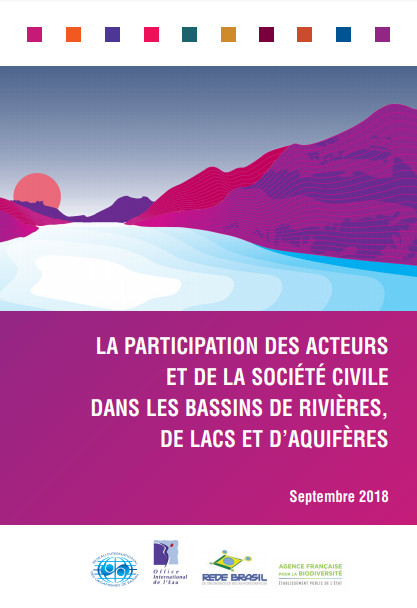La participation des acteurs et de la société civile dans les bassins de rivières, de lacs et d'aquifères
 |
rapport Sep 2018 ; 72 pages
Ed. RIOB - Paris
Téléchargeable sous format: PdF
Téléchargeable chez l'éditeur
Page de présentation d'un éditeur
Résumé:
Ce document souligne l’importance de la participation dans la gestion des ressources en eau. Il décrit les éléments clés de la participation à la gestion de l’eau et donne de nombreux exemples concrets de bassins du monde entier qui montrent ce qui peut être fait pour que la participation des parties prenantes et de la société civile devienne une réalité et une valeur ajoutée dans le processus de prise de décision au niveau du bassin.
La participation des acteurs et de la société civile dans la gestion de l’eau est, depuis de nombreuses années, considérée, à juste titre, comme une condition importante de réussite dans l’atteinte des objectifs de la politique de l’eau. En effet la participation permet à la fois une meilleure compréhension de la stratégie et de la politique de l’eau, une appropriation par toute la population du diagnostic des situations, des approches et des décisions d’action. Elle permet aussi une application plus efficace des réglementations. Ce constat est valable quel que soit le niveau d’action. La participation des acteurs et de la société civile est ainsi un élément déterminant dans la gestion de l’eau à l’échelle des bassins qu’ils soient nationaux ou transfrontaliers.
Cependant, ce mot de « participation » est devenue au fil du temps un « foure-tout » qui, selon les auteurs, prend des sens différents. On parle de la participation des acteurs de la société civile, des usagers, des citoyens, de la population. On cible aussi les associations, les organisations non gouvernementales et, bien sûr, les entités ou administrations publiques gouvernementales ou territoriales. De même, différents types de participation apparaissent selon la situation dans laquelle on se trouve. Enfin les spécialistes décrivent plusieurs degrés de participation allant de la simple information à un réel partage de la responsabilité.
Le présent document vise à éclairer la thématique de la participation à l’échelle des bassins à partir d’exemples réels, pratiques, concrets qui témoignent de leur faisabilité.
Le chapitre II donne des éléments sur le type d’acteurs ou usagers qui doivent participer à la gestion des ressources en eau dans le bassin.
Dans les chapitres III et IV sont analysés les différents mécanismes qui permettent d’assurer la participation des acteurs économiques et de la société civile dans les bassins, que ce soit dans le cadre de dispositifs formels ou informels. Abstract:
This document highlights the importance of participation in water resources management. It describes the key elements of participation in water management and gives many concrete examples from basins around the world that show what can be done to make stakeholder and civil society participation a reality and an added value in the decision-making process at the basin level.
Stakeholder and civil society participation in water management has, for many years, been rightly for many years, rightly considered as an important condition for success in achieving the in achieving the objectives of water policy. Indeed, participation allows both a better understanding of the strategy and the water policy, an appropriation of the diagnosis of by the whole population of the diagnosis of the situations, of the approaches and of the decisions of action. It also allows for a more efficient application of regulations. This observation is valid This observation is valid regardless of the level of action. The participation of the actors and of the civil society is thus a determining element in water management at the scale of basins, whether national or transboundary. national or transboundary.
However, this word "participation" has become over time a "catch-all" which, depending on the authors, takes on different meanings, according to the authors, takes on different meanings. We speak of the participation of the actors of the civil society, users of civil society, users, citizens, the population. It also targets associations, non-governmental organizations and, of course, the public, non-governmental organizations and, of course, governmental or territorial entities or administrations. governmental or territorial public entities or administrations. In the same way, different types of participation appear according to the situation in which we situation. Finally, specialists describe several degrees of participation ranging from simple information to a real sharing of responsibility.
This document aims to shed light on the theme of participation at the basin level from real, practical, concrete examples that demonstrate their feasibility.
Chapter II gives elements on the type of stakeholders or users who should participate in management of water resources in the basin.
Chapters III and IV analyze the different mechanisms that allow to ensure the participation of the economic actors and the civil society in the basins, whether within the framework of formal or informal mechanisms.
This document aims to shed light on the theme of participation at the basin level, using real, practical, concrete examples that demonstrate their feasibility.
Chapter II gives elements on the type of stakeholders or users who should participate in the management of water resources in the basin.
Chapters III and IV analyze the different mechanisms that ensure the participation of economic stakeholders and civil society in the basins, whether within the framework of formal or informal arrangements.
Mot clef: |
Editeur/Diffuseur: |
|
RIOB
-
Réseau International des Organismes de Bassin - Paris |
En cas de lien brisé, nous le mentionner à communication@pseau.org